![]()
![]()
![]()
Use LEFT and RIGHT arrow keys to navigate between flashcards;
Use UP and DOWN arrow keys to flip the card;
H to show hint;
A reads text to speech;
52 Cards in this Set
- Front
- Back

Name? Location? Period? Style? |
Hierakonpolis Upper Egypt Predynastic Period Egyptian Painting
|
|

What do the arcs represent in this painting? |
'Ships of the dead' When you die you get in a boat towards an 'eternal realm'
|
|
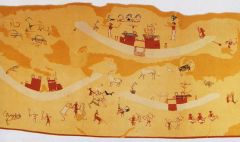
This piece is an example of funerary art, which is.... |
Art focusing on death and the after life |
|
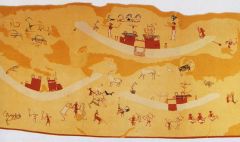
What are recurring motifs in this painting? |
-Wheel circled by a quadruped -Human with 2 giant cats, animals in profile |
|
|
What is a dompting motif? |
-Human standing between 2 profiled beasts and seems to be subduing them -Human is overpowering 2 beasts. Mediteranean concept- prevails across space and time. |
|
|
Rasied relief? |
positive field is raised, negative field is excavated distinct visual rendering |
|
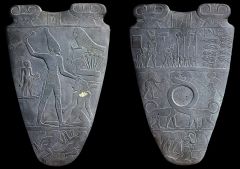
Name? Location? Period? Style? |
Palette of Narmer 2950 BCE Carved in Relief |
|
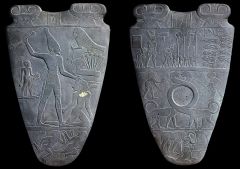
Narmer's Palette
Why is the figure so prominent/how do we know he is important? |
-Everything else seems to be responding to him -He is large -There is more detail especially in the upper arm/muscles -He is wearing a 'crown', and holding a mase(as a weapon) -His pose/ stance. He is wearing a detailed kilt. -Holds the tail of a bull on his hips. (shows status) -Smaller man is being subdued and threatened.
|
|
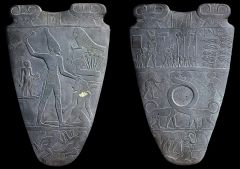
Narmer's Palette Explain the falcon
|
Falcon God- Leader One claw of the falcon is functioning as a human hand. Tether suggests a power relationship- falcon is controlling person underneath. Similar to relationship btwn Namer(Upper Egypt) and smaller man(Lower Egypt) on opposite side. -Upper Egypt Conquering Lower Egypt |
|
|
What is a composite Creature. (Falcon in Narmer's Palette is a Composite Creature) |
A creature that consists oof 2 or more species i.e. a Centaur
-Narmer's palette falcon has a 'hot dog body', papyrus plants growing out. |
|
|
What does Papyrus represent? |
Lower Egypt- Papyrus grows there. |
|
|
What is Hierarchic Art? |
Artist is trying to tell viewer who is most/ least important. |
|
|
How does hierarchic art show viewer who is more/less important? |
The artist makes the most important person bigger and more powerful and depicts them in fancy clothes (kilt/crown), often bearing a weapon and in the middle of the composition. Usually others are looking at him but he does not look back at them. |
|
|
What pose is the most important person in hierarchic art usually depicted in? |
Profile face, frontal eye, frontal chest, profile hips/legs. Stiff and Unnatural Appears Supernatural |
|
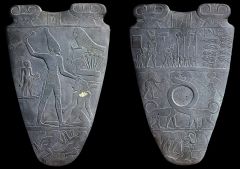
What is being depicted in the bottom register |
Enemies fleeing as they're being overtaken |
|
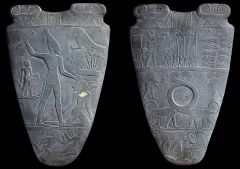
What is in the 3rd register
|
Bilateral Symmetry Humans controlling composite creatures-panthers with snake necks |
|
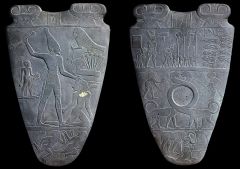
Who is the most important in the 2nd register? why? |
The man at the far left. -seems to be controlling a small army -bodies on far right are viewed from above, everything else is viewed laterally
|
|
|
How is Narmer's Palette propagandistic art? |
Shows body count after battle. Very literal-shows decapitation. |
|
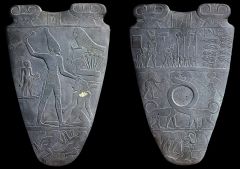
Standard Bearers? (Small Army) |
Don't have weapons, carrying standards with different symbols on top. A way for Narmer to speak to and organize troops. |
|
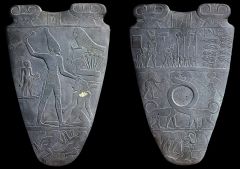
Lower sector? |
Bull is trampling a woman, butting a piece of architecture shown laterally. Bull is a representation of Narmer. Many cultures associate leaders with Bulls. |
|
|
Crown of Upper Egypt? Lower Egypt? |
White Crown Red Crown These crowns merge to become single, very exotic crown in the palette of harmer |
|
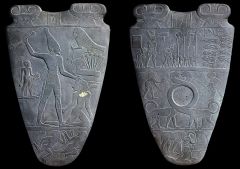
What was the circle between snake lions necks used for? |
To hold powder that was placed on a persons face. It was placed on a flat surface with back facing up. In this context, the back would be considered more important.
|
|
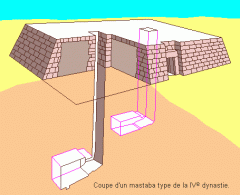
whats this thing |
Mastaba- 4 sided pyramid, sides slant inward, flat top. |
|
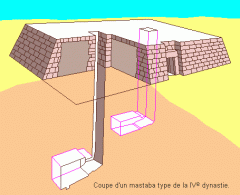
Whats a mastaba? |
-Structure which is partly above the ground. -Person is buried underground- burial place for nobility -Air shaft to burial chamber.
|
|

Whose pyramid/ what is it called |
Imhotep King Djoser's Pyramid -funerary district/burial place |
|
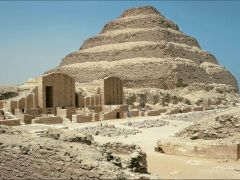
What kind of pyramid |
A Step Pyramid- composed of many mastabas |
|

Why did King Djoser get so many mastabas? |
Great kings get many mastabas upon one another. Djoser is great king. Gets lots of mastabas
|
|
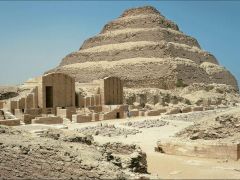
When was this built/ |
2500 BCE
|
|
|
What is a buttress wall? |
periodical thickening of a wall, making the wall strong |
|
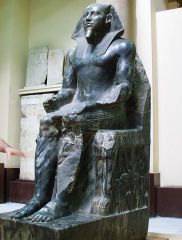
Name when? what dynasty? what is it made of?
|
Khafre 2500 BCE Dynasty 4 Stone (Gneiss) |
|
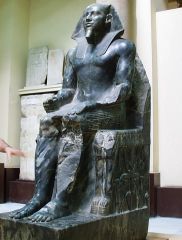
proportions? is it anatomically correct? pose? expression? |
-proportions are normal -anatomy is summarized not specific. there is slight muscle definition -pose is frontalized, he is bilaterally symmetrical. -Subdued, solemn expression, lips closed.
|
|
|
Monolithic- |
one piece of stone
|
|

process? |
begin with big round boulder, chip away until it becomes an oblong block. drawing guides them through the rest.
|
|

Rectilinear approach (right angles) allows for... |
allows us to see side w/ papyrus pants representing lower egypt |
|
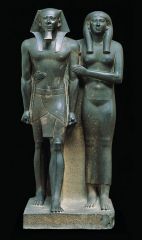
who are these guys |
Menkaure and a queen |
|
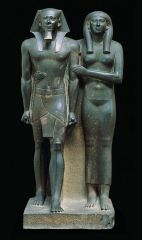
Menkaure and a Queen- sensual? |
Clothes revealing the body |
|
|
What are the 3 major egyptian poses |
1. Seated Figure (rectilinear) 2. Striding Figure (standing as if walking) 3. Seated cross legged pose
|
|
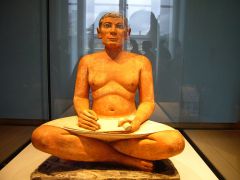
Name? Date? Material? Pose? |
Seated Scribe 2400 BCE, Dynasty 5 Stone Frontalized -more realistic -solemn -inlaid eyes |
|

Name? Date? Site?
|
Ti Watching A Hippopatomus Hunt 2400 BCE Saqqra |
|
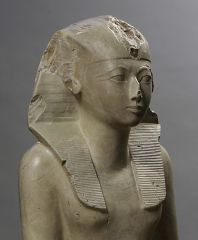
Who is this? When? Where? What did she do |
Queen Hatshepsut 1473-1458 BCE Deir el-Bahri She took a long trip to the Land of Punt |
|
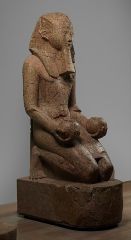
? |
Kneeling figure of hatsheput
|
|
|
a funerary temple has... |
ramps and terraces
|
|
|
Clerestory- |
-Upper level of windows that brings light into interior. |
|
|
Papyrus capitals- bud capitals- |
top of column that takes the shape of papyrus, top of column that takes the shape of buds
|
|
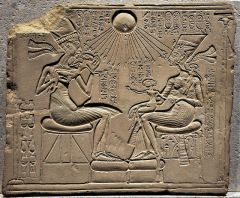
Who are they? WHen?
|
Akhenaten and His Family 1350 BCE |
|

pose? symmetry? significance of sun? |
-Seated pose, head and legs in profile, eyes and chest frontal -Bilaterally symmetrical compostition -sun with rays shining on family- symbol of their monotheism (worship only 1 god)
|
|
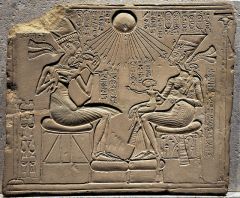
material? method? proportions? |
-Stone -Sunken Relief -Children are just smaller versions of adults. Strange proportions. Bulbous back of head and skinny neck. Big stomach and small waist. Different from Khafre |
|
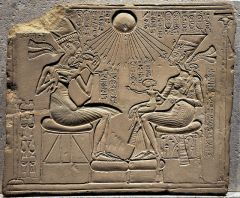
EMotion? ANKH? |
Child reaching up to mother shows emotion- uncommon in egyptian art. Hands in the sun disk are holding ANKH- |
|
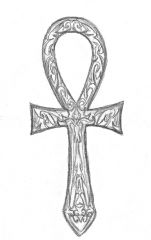
|
ANKH- Heiroglyphic representing the concept of eternal life. |
|
|
Encaustic |
type of painting usually done on wood using wax as the liquid |
|
|
Funerary portraits (i.e. mummy wrapping of a young boy 100-120 CE; portrait of boy on coffin) |
Figure looks at us, light comes from above. Sparkle in the eyes. Sad eyes, lips closed. Encased in strips of cloth. |
|
|
Faiyum |
Encaustic Portraits |

